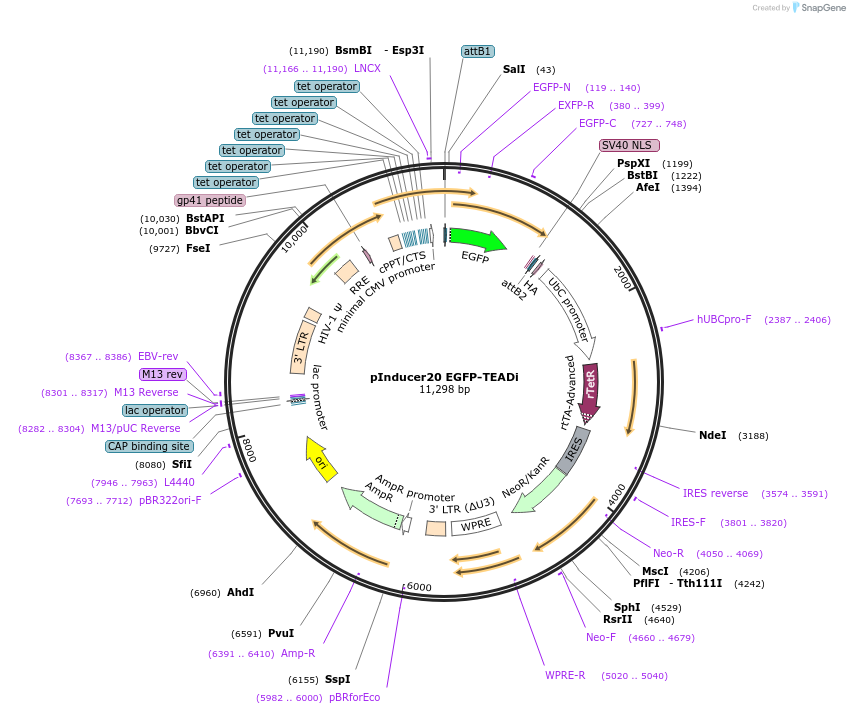-
PurposeTetracycline-inducible TEADi (GFP-tagged inhibitor of the interaction of YAP1 and TAZ with TEAD transcription factors with nuclear localization signal)
-
Depositing Lab
-
Sequence Information
Ordering
| Item | Catalog # | Description | Quantity | Price (USD) | |
|---|---|---|---|---|---|
| Plasmid | 140145 | Standard format: Plasmid sent in bacteria as agar stab | 1 | $89 | |
Backbone
-
Vector backbonepInducer20
- Total vector size (bp) 11263
-
Vector typeMammalian Expression, Lentiviral
-
Selectable markersNeomycin (select with G418)
Growth in Bacteria
-
Bacterial Resistance(s)Ampicillin, 100 μg/mL
-
Growth Temperature37°C
-
Growth Strain(s)NEB Stable
-
Copy numberUnknown
Gene/Insert
-
Gene/Insert nameEGFP TEADi
-
Tag
/ Fusion Protein
- EGFP (N terminal on insert)
Cloning Information
- Cloning method Gateway Cloning
- 5′ sequencing primer LNCX_primer
- (Common Sequencing Primers)
Resource Information
-
Supplemental Documents
-
Articles Citing this Plasmid
Terms and Licenses
-
Academic/Nonprofit Terms
-
Industry Terms
- Not Available to Industry
Trademarks:
- Zeocin® is an InvivoGen trademark.
Depositor Comments
For better TEAD inhibition select high expressing clones or with high dose of neomycin. We have observed that in certain cancer cell lines TEADi gets degraded or is expressed at low levels, resulting in incomplete TEAD inhibition. We recommend checking by Western Blot with anti-GFP antibody that the correct molecular weight of the full construct is expressed (approximately 39kDa) and check that known targets of TEAD are downregulated upon expression of TEADi. As with other dominant negative proteins, good levels of expression are necessary for TEADi to block TEADs.
These plasmids were created by your colleagues. Please acknowledge the Principal Investigator, cite the article in which the plasmids were described, and include Addgene in the Materials and Methods of your future publications.
-
For your Materials & Methods section:
pInducer20 EGFP-TEADi was a gift from Ramiro Iglesias-Bartolome (Addgene plasmid # 140145 ; http://n2t.net/addgene:140145 ; RRID:Addgene_140145) -
For your References section:
YAP1/TAZ-TEAD transcriptional networks maintain skin homeostasis by regulating cell proliferation and limiting KLF4 activity. Yuan Y, Park J, Feng A, Awasthi P, Wang Z, Chen Q, Iglesias-Bartolome R. Nat Commun. 2020 Mar 19;11(1):1472. doi: 10.1038/s41467-020-15301-0. 10.1038/s41467-020-15301-0 PubMed 32193376



